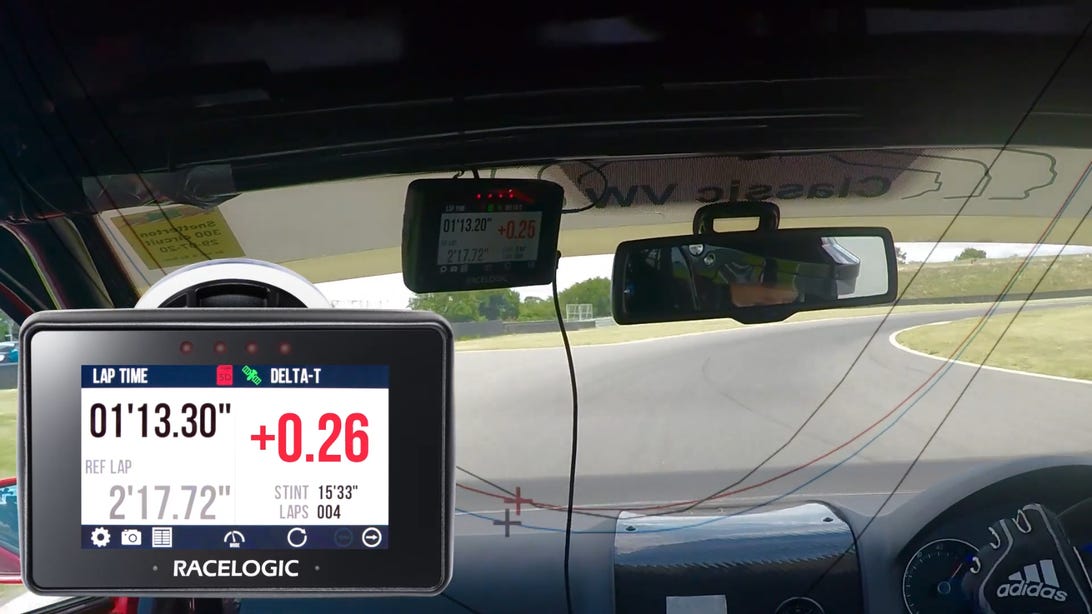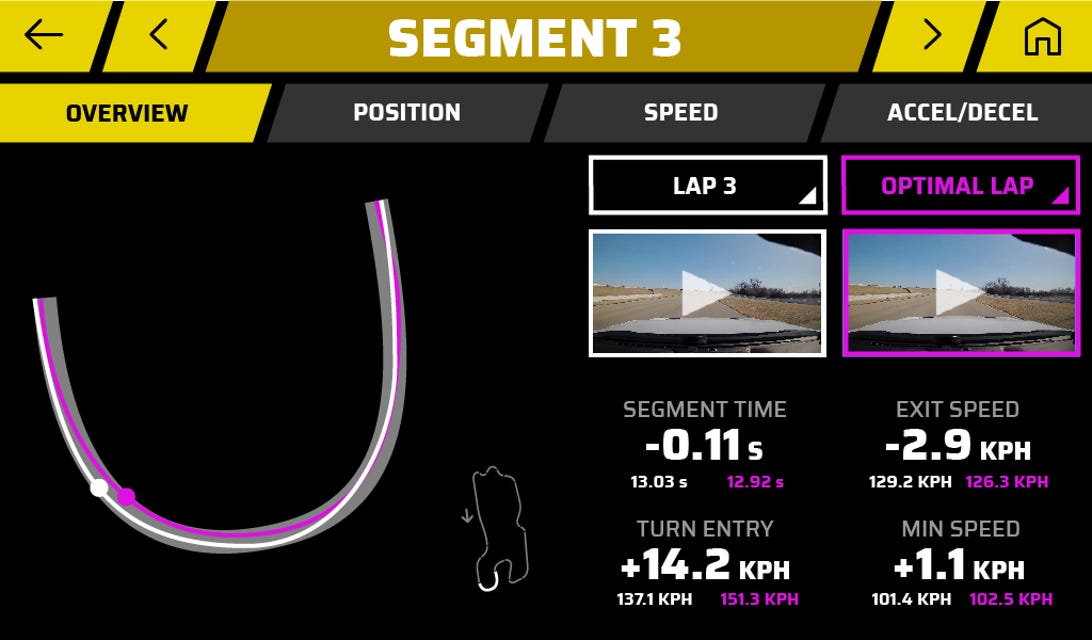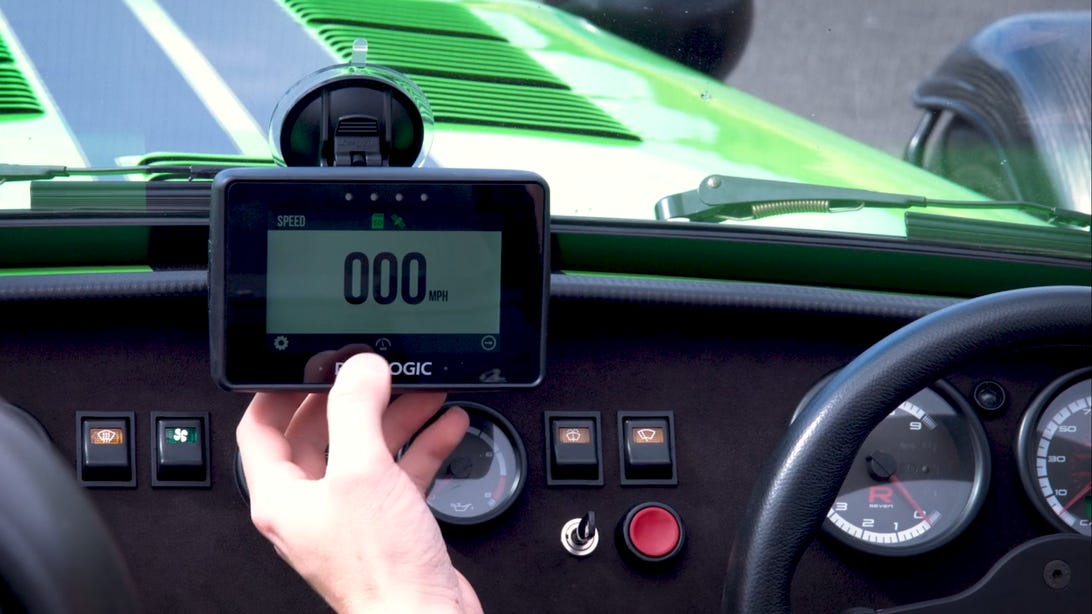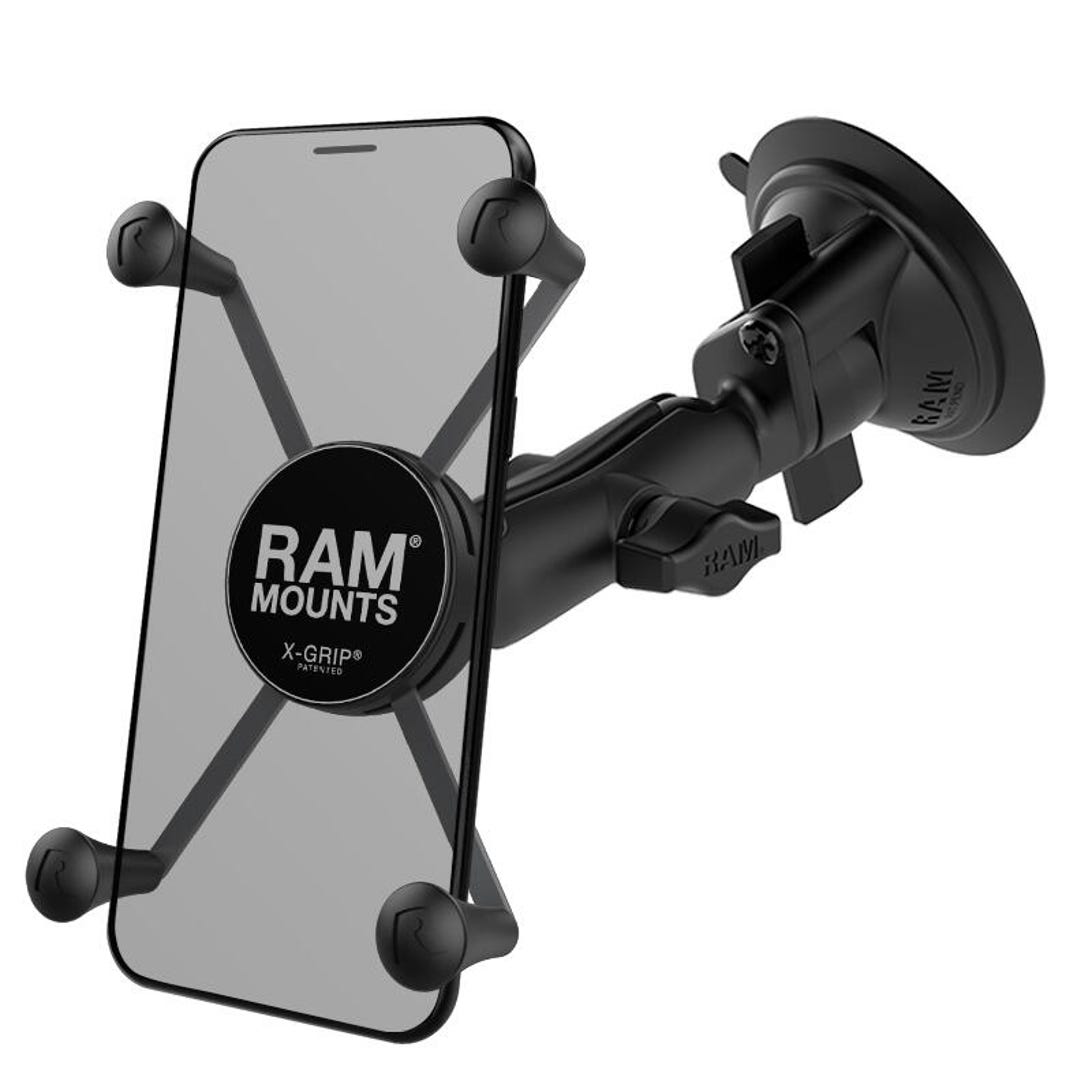Best lap timer for 2021 – Roadshow [CNET]
If you love cars, odds are good that you also love going fast. And while the casual exhilaration of speed on a perfectly twisting road or the accomplishment of tackling a tough trail are enough for many of us, the more driven feel the need to go faster. Of course, one can make a car faster with more power or suspension improvements, but the best (and cheapest) performance upgrade that you can make is to the component between the seat and the steering wheel: you, the driver.
One of the best tools to help you become a faster driver is a precise lap timer. While that can be as simple as setting a stopwatch at the start of each session, most dedicated racing lap timers use GPS to automatically mark each lap’s beginning and end, separating the time for each and allowing the user to see how changes to your racing line and braking points affect your overall speed. The best examples also log and save your sessions digitally — often along with vehicle performance data or video — for review later.
Of course, it can be difficult for a novice to look at GPS data and lap times and know exactly how to go faster. Ideally, this is where an experienced driving coach comes in to help make heads or tails of the information. However, if you can’t find human help, a new class of digital track coaching devices may be able to help. These devices use a combination of artificial intelligence and predictive lap timing to analyze the logged data and make suggestions, often in real time on the track, to improve your speed for each subsequent lap.
Comparison of the best lap timers
| Brand | Model | Price | Description | |
| Best lap timer overall | Aim Sports | Solo 2 | $400 | Matching plug-and-play simplicity with extreme precision, the Aim Solo 2 (or the upgraded Solo 2 DL) is the best GPS timer for most racers, novice to experienced, for all types of racing. |
| Best lap timer runner-up | Racelogic | Performance Box Touch | $680 | The Performance Box Touch is pricier than its primary competitor, but also boasts a color screen and the promise of better predictive lap timing. |
| Best lap timer if money is no object | Aim Sports | Solo 2 DL / Smartycam HD 2.1 | $1,700 | This Track Day Kit can automatically log lap times, monitor vehicle systems and sensors and automatically overlay that data onto an HD video to analyze and share. |
| Best screenless lap timer | Racelogic | Vbox Sport | $420 | It lacks a screen, but the Vbox Sport still logs timing and location data with extreme precision. Plus, its compact, waterproof design makes it ideal for use on boats or even R/C craft. |
| Best track driving coach lap timer | Garmin | Catalyst | $1,000 | The Garmin Catalyst not only logs your laps with HD video and precise GPS, but its AI software also analyzes the data for you and makes suggestions that help you go faster next round. |
| Best lap timer app | HP Tuners | TrackAddict | Free | TrackAddict is a streamlined lap timer app that makes it easy to get setup recording sessions at the track. Most importantly, it’s free to get started. |
| Best lap timer app runner-up | Harry’s | Harry’s Lap Timer Petrolhead | $20 | Harry’s Lap Timer is a longstanding favorite. It’s more expensive than TrackAddict and it’s a bit more complex, but its enhanced analysis tools make it a better pick for seasoned drivers. |
| Best dashboard replacement lap timer | Aim Sports | MXG Dash | $2,600 | Replacing your entire instrument cluster with a lap timer/data logger is probably overkill, but for purpose-built race cars (and trucks) the Aim MXG is the best in the business. |
What should a good lap timer do?
The obvious answer is that a lap timer should accurately measure, separate and store your lap times while you race around a track, but it’s a skosh more complex than that. For starters, you’ll be too busy driving to manually mark your laps, so a good lap timer should make use of GPS to automatically track when you cross the start-finish line.
The best lap timers will store your laps for analysis and comparison with future sessions and should also provide some sort of performance feedback while on the track. This could be as simple as displaying a split time or more complex.

The addition of a handlebar mount enables the Aim Solo 2 to be used on motorcycles, as well.
Aim SportsWhat to look for in a GPS lap timer?
The more accurate the device’s positioning, the more accurate your measured times will be, so a high-quality GPS antenna is paramount. Look for a receiver compatible with the Global Navigation Satellite System, which combines tracking on both the GPS and GLONASS satellite constellations for the most precise positioning.
At 80 mph, a car travels around 117 feet every second. So, for fast moving vehicles on a race track, refresh rate (measured in hertz) for positioning data is just as important as accuracy. I’ve seen specialty GPS trackers reach as high as 16 to 20Hz, but most good lap timers will have a refresh rate of around 10Hz. Extremely cheap timers (or older smartphones) can dip as low as 1 to 6Hz, which causes inconsistent detection of the start/finish line and inaccurate timing.
Speaking of the finish line, a good lap timer built for racing applications should have built-in location data for popular racetracks. That doesn’t mean you’ll be looking at a map, but having the same position for the finish line (as well as the same starting points for track segments) makes it easier to compare and share your time and performance with other drivers.
Though not strictly necessary — as with the screenless Vbox Sport — a large, easy-to-read display is very nice to have. Of course, ideally you’ll be watching the grid and not the clock once the green flag drops, but big, legible numbers means that you won’t have to squint to glance at your split. Along that same line, a good lap timer should also be a data logger, since it’s much safer and easier to look at lap data from the pits.

Predictive timing helps the driver improve with immediate feedback on changes to the racing line.
Vbox MotorsportWhat is predictive lap timing?
A split time is the difference between your pace on your current lap and that of your previous best. Race tracks are broken up into segments and splits are usually calculated at the end of each one. So if you get to the end of the first segment a second sooner than last time, your split is minus 1 second. However, if you lose two ticks on the next segment, its split will be plus 2 seconds and, at the end of the lap, your total split will be plus 1 second. Split timing aids in finding the sections of the track that are giving you the most trouble and can help you see how adjustments affect your overall lap time.
Predictive timing — sometimes called delta timing — takes that concept a step further, calculating in real time how your current performance stacks up with your previous best and estimates of how long your current lap will take based on changes to your racing line, acceleration and braking. This can be as simple as an LED that turns green when you’re faster and red when slower, or a live updating lap time prediction. If, for example, braking a touch earlier in a specific bend results in a faster exit speed, you may see your predictive time drop instantly. This makes it easier to pinpoint small improvements that can be lost waiting to complete a lap or even the current segment.
What is a driving coach?
Experienced drivers are able to look at their lap times, maybe compare notes with other drivers and see where improvements can be made. However, novice racers may need the help of a driving coach to make heads or tails of the data. While there is no replacement for an experienced human riding shotgun, digital driving coaches like the Garmin Catalyst or the Apex Pro Driving Coach can be extremely helpful.
Digital coaching is like predictive lap timing on steroids, going beyond just showing when you’re faster to telling you how to get faster. The Catalyst combines GPS, accelerometer and camera data to track you. At the end of your session, the best segments of multiple laps are combined into a True Optimal Lap — a hypothetical best lap based on your performance.

Catalyst’s coolest feature is its ability to generate a “True Optimal Lap” based on your captured data and video.
GarminThis, in itself, isn’t particularly special — many lap timers can calculate an optimal lap — but the difference is that the Catalyst takes that data and uses it to give feedback on your next driving session. The AI will give audio prompts and hints telling the driver to, for example, brake later here, apex sooner there, or stay on the gas just a bit longer. The more laps you complete, the better the suggestions returned by the Catalyst. Additionally, because the optimal lap is based on your best segments, the driving coach also grows with your skill cap.
How do you mount a lap timer?
Most standalone racing lap timers will ship with some form of suction-cup mount, but not always. Make sure to check before you buy. A suction cup is the easiest mounting option, allowing the device to be attached to the windshield like a GPS navigator or radar detector and then easily removed at the end of your lapping session. Windshield mounting also gives a lap timer’s GPS antenna the clearest view of the sky for the best satellite positioning accuracy.
A more secure mounting option is a bolt-in dashboard bracket. This semipermanent mounting method is more secure than a suction cup — especially in the event of a collision — and has the added benefit of keeping your windshield clear of obstructions. Of course, you may have to modify or drill into your dashboard to bolt it in, and you’ll want to make sure that your chosen mounting position doesn’t block the GPS antenna.
For motorcycle and powersports applications, a handlebar mount can be used to hold your lap timer securely in place. Aim even offers padded bar mounts for its Solo 2 and Solo 2 DL models. Full instrument cluster replacements like the Aim MXG are the most time and labor intensive installations and should only be attempted if you absolutely know what you’re doing.

Windshield or dashboard mounting gives the lap timer the best connection to the satellite constellations and the most accurate timing.
Vbox MotorsportThings to consider about lap timer apps
The most cost-effective way to start timing your laps today is to download a lap timer app and simply use the phone that’s already in your pocket. Apps like Harry’s Lap Timer and TrackAddict offer feature sets that rival the best dedicated GPS lap timers on this list, but there are a few catches.
The performance of a lap-timer app is highly dependent on your phone, since it’s the handset’s GPS and accelerometers doing the heavy lifting. Newer devices are usually up to the task, but an older phone can be to blame for an inconsistent and frustrating lap-timing experience. There are a few things you can do to give your phone a leg up.
First, you’ll need to budget for a dashboard or windshield mount; your pocket or a cup holder won’t do. The phone will need a clear view of the sky to give its GPS antenna the best shot at accurate positioning. Look for a firm, stable mount — not one of those flexible goosenecks — that locks into place and allows the accelerometers to more precisely measure G-forces, ensures that the handset won’t go bouncing around the cabin when you hit a bump and may even let you use your phone’s camera to record video of your laps. As an added benefit, you can also use the mount when navigating home at the end of the day.

A locking mount, like this Ram X-Grip Suction Cup, will hold your phone more securely than a cup holder while timing laps and improve GPS accuracy.
Ram MountsA mobile phone’s GPS is designed with power management and navigation in mind, which can mean compromising on refresh rate. Many older phones can have GPS refresh rates as low as 1 to 6Hz, which is fine for turn-by-turn directions but isn’t the best for precise, high-speed measurement. That refresh rate may drop even lower — below even 1Hz — to help save power when the screen is off or the battery is low, even on relatively new phones. So, you’ll want to keep your phone plugged in and awake during your laps.
If your phone’s not cutting it but you don’t want to make the jump to a dedicated timer, consider augmenting your device with an external Bluetooth GPS antenna — like the Vbox Sport or the Garmin GLO 2 — to add more precise, high-refresh positioning. Both Harry’s and TrackAddict support dozens of third-party receivers, but you’ll want to double-check for compatibility with your phone’s OS. You can also add an adapter that connects to your car’s diagnostics port to allow the app to capture ECU data, such as engine speed, throttle position and more.

![best-lap-timer-for-2021-–-roadshow-[cnet]](https://i0.wp.com/upmytech.com/wp-content/uploads/2021/06/33608-best-lap-timer-for-2021-roadshow-cnet.png?resize=800%2C445&ssl=1)
![how-data-should-really-be-used-to-drive-strategy-and-differentiation-[venturebeat]](https://i0.wp.com/upmytech.com/wp-content/uploads/2022/07/76635-how-data-should-really-be-used-to-drive-strategy-and-differentiation-venturebeat.jpg?resize=390%2C205&ssl=1)
![save-up-to-55%-on-xbox-games-and-get-$50-off-turtle-beach-headphones-–-cnet-[cnet]](https://i0.wp.com/upmytech.com/wp-content/uploads/2020/12/18614/save-up-to-55-on-xbox-games-and-get-50-off-turtle-beach-headphones-cnet-cnet.jpg?resize=300%2C169&ssl=1)
![relativity-acquires-text-iq-to-augment-ai-platform-for-lawyers-[venturebeat]](https://i0.wp.com/upmytech.com/wp-content/uploads/2021/05/31149-relativity-acquires-text-iq-to-augment-ai-platform-for-lawyers-venturebeat.png?resize=390%2C205&ssl=1)